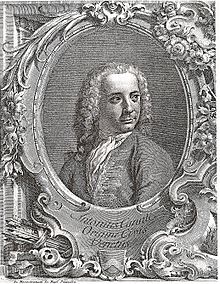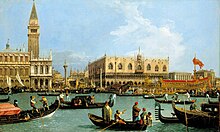Giovanni Antonio Canal


Giovanni Antonio Canal (* 7. Oktober 1697 in Venedig; † 19. April 1768 ebenda), genannt Canaletto, war ein bedeutender italienischer Vedutenmaler.
Leben

Canaletto lernte die Malerei in der Werkstatt seines Vaters Bernardo Canal, der Bühnenbilder für Theateraufführungen herstellte. Berühmt wurde er durch die Bilder seiner Heimatstadt Venedig sowie durch Capricci. Sie bestechen durch ihre fast fotorealistisch genaue und detailreiche Darstellung. Um diese Präzision zu erreichen, benutzte er als Hilfsmittel eine Camera obscura.
Antonio Canal ist zu unterscheiden von seinem Neffen Bernardo Bellotto, der in sehr ähnlicher Weise arbeitete und später ebenfalls den Künstlernamen „Canaletto“ verwendete. Antonio Canals Arbeiten sind insgesamt lichtvoller, zumeist heiterer und auch heller als die seines Neffen.
Einer der Mäzene und Auftraggeber Canalettos war der englische Konsul in Venedig Joseph Smith, der auch 1728 Antonio Visentini mit den Stichen zu Canalettos venezianischen Veduten unter dem Titel Venetiarum nobis Prospectus, beauftragte und damit für die Verbreitung der Werke unter den auf der Grand Tour reisenden englischen Adligen sorgte. Die Bilder wurden entweder über Smith von den englischen Adligen erworben oder unmittelbar von England aus bestellt. So beauftragte 1731–1732 der 4. Duke of Bedford 24 Gemälde, die Antonio Canal von 1732 bis 1736 ausführte. Anschließend folgten Aufträge durch den 3. Duke of Marlborough für weitere 20 Bilder und 1738 bestellte Henry Howard, 4. Earl of Carlisle, 5 großformatige Leinwände.[1] Nach dem Ausbruch des Österreichischen Erbfolgekrieges 1740 sank die Zahl seiner Aufträge. Canal ging 1746 für zehn Jahre nach England, nachdem er von Jacopo Amigoni, der als Künstler dort mehrere Jahre verbracht hatte, von den dortigen Lebensumständen erfahren hatte, und gewann den Duke of Richmond als Mäzen. Seine dort entstandenen Bilder wirken leichter und lebhafter. Sie zählen zu den besten Darstellungen Londons im 18. Jahrhundert. Die letzten Jahre seines Lebens verbrachte er wieder in Venedig. Seine Bilder wurden dunkler, waren aber immer noch voller Überraschungen.
Werke (Auswahl)
- Markusplatz in Venedig
- Campo di Rialto, Venedig
- Flusslandschaft mit Säule und Triumphbogen
- Canal Grande in Venedig
- Ansicht des Bacino di San Marco in Venedig, 1735, Städelsches Kunstinstitut
- Campo santi Giovanni e Paolo mit dem Denkmal des Bartolomeo Colleoni (1741) – Öl auf Holz
- Burg Alnwick, Nordengland
- Blick durch die Westminster Bridge auf London (1747)
Auflistung:
- San Marco-Platz, Venedig (1720er).[2]
- Teilansicht des San Marco-Platzes in Venedig (um 1735).
- St. Johannes und Paul-Areal mit dem Denkmal des Bartolomeo Colleoni (1741).
- Porta Portello, Padua (1741/1742).[3]
- Der Pra' della Valle in Padua (1741–1746).[4]
- Blick durch die Westminster Bridge auf London (1747).
- Architektonisches Capriccio mit Ruine und klassizistischen Bauten (1756).[5]
- Kupferstiche und Zeichnungen von Canaletto
- Blick von der Rialto-Brücke über den Canal Grande
- Wasserfest auf dem Canal Grande, Venedig
- Campo San Giovanni e Paolo, Venedig
Eine Monographie über Antonio Canal listet folgende Radierungen auf:[6]
- Das Titelblatt.
- La Torre di Malghera.
- Mestre
- Al Dolo.
- A. le Porte del Dolo.
- Là Porte del Dolo.
- Pra della Valle.
- Am Canal der Brenta.
- Der Bogen mit der Laterne.
- Murano.
- Das Haus mit MDCCCXLI A. C. (mit Folgendem auf einem Bogen zusammen)
- Das Haus mit dem Säulenvorbau.
- Die Cascade (einzeln).
- La Libreria V. (mit den Folgenden 3 auf einem Bogen zusammen)
- La Pieva del Bando V.
- Der Marktplatz an der Ponte Rialto.
- La Preson V.
- Die Gebiergs-Landschaft. (mit den Folgenden 3 auf einem Bogen zusammen)
- Die Osterie am Canal.
- Die Terrasse.
- La Procuratie nuove e S. Ziminian V.
- Am Ufer der Brenta. (mit den Folgenden 3 auf einem Bogen zusammen)
- Der betende Pilger.
- Der verfallene Thor.
- Das Thorgebäude mit dem Ziehbrunnen.
- A Capo d'Istria. (mit Folgendem auf einem Bogen zusammen)
- Die Ruinen der Pyramide.
- Das Marienbild bei der Kapelle. (mit den Folgenden 2 auf einem Bogen zusammen)
- Die Landschaft mit dem Monument.
- Die kleine Brücke mit der Osterie.
weiter werden dort in England gemalte Werke aufgeführt (siehe auch:[7]):
- Vue de la grande Promenade (Vauxhall-Garten)
- Vue de Canal et batiment chinois (Barclay's Garten)
- Temple de Comus (Vauxhall-Garten)
- Vue de Centre etc.
- Interieur de Rotunda
- Vue de la grande Parade du Parc de S. James
- Vue de la maison de Northumberland
- Vue du Canal et de la maison de Buckingham
Literatur
- Andreas Henning, Axel Börner, Andreas Dehmer (Hrsg.): Canaletto. Ansichten vom Canal Grande in Venedig. Kabinettausstellung anlässlich der Restaurierung zweier Gemälde von Giovanni Antonio Canal, genannt Canaletto (= Das restaurierte Meisterwerk. Bd. 5). Sandstein, Dresden 2008, ISBN 978-3-940319-28-9.
- J. G. Links: Canaletto. Complete revised, updated and enlarged. Phaidon, London 1994, ISBN 0-7148-3170-0 (Reprinted edition. ebenda 1999, ISBN 0-7148-3843-8).
- Fritz Löffler: Bernardo Bellotto genannt Canaletto. Dresden im 18. Jahrhundert. 6. Auflage. Seemann, Leipzig 2015, ISBN 978-3-86502-116-8.
- Martin Schwander (Hrsg.): Venedig. Von Canaletto und Turner bis Monet. Hatje Cantz, Ostfildern 2008, ISBN 978-3-7757-2240-7.
- Dorothea Terpitz: Giovanni Antonio Canal, genannt Canaletto. 1697–1768. Könemann, Köln 1998, ISBN 3-8290-0684-5.
- Octave Uzanne: Canaletto. Parkstone Press International, New York NY 2008, ISBN 978-1-84484-505-7.
- Egon Grund: Canalettos Veduten als Wirklichkeitskonstruktion unter besonderer Berücksichtigung der Frage: Benutzung der Camera obscura? Dissertation, Univ. Göttingen 2008.
Weblinks
- Literatur von und über Giovanni Antonio Canal im Katalog der Deutschen Nationalbibliothek
- Werke von Giovanni Antonio Canal bei Zeno.org
- Canaletto bei artfacts.net
- Canaletto bei artcyclopedia.com (engl.)
- Venice: Canaletto and His Rivals Ausstellung in der National Gallery of Art, Washington, D.C., 2011 (engl.)
- Canaletto in England: A Venetian Artist Abroad, 1746–1755, Ausstellungskritik in New York Times, 24. November 2006
- Canaletto-Informationen, Kulturseite der Region Lombardei, Pavia (ita.)
Einzelnachweise
- ↑ Sotheby’s, London 4. Dezember 2013, lot 39
- ↑ Piazza San Marco, Ölgemälde, 1720er Jahre, im Metropolitan Museum of Art, USA.
- ↑ The Porta Portello, Padua, Ölgemälde, c. 1741/1742, in der National Gallery of Art, USA.
- ↑ Il Pra' della Valle in Padova, Ölgemälde, 1741–1746, im Museo Poldi Pezzoli, Italien.
- ↑ Capriccio architettonico con rovine ed edifici classici, Ölgemälde, um 1756, im Museo Poldi Pezzoli, Italien.
- ↑ Die beiden Canaletto, Meyer, Rudolph, Dresden, 1878 in der Staatsbibliothek zu Berlin.
- ↑ Royal Collection Trust – Canaletto, Windsor Castle, Großbritannien.
| Personendaten | |
|---|---|
| NAME | Canal, Giovanni Antonio |
| ALTERNATIVNAMEN | Canaletto |
| KURZBESCHREIBUNG | italienischer Veduten- und Landschaftsmaler |
| GEBURTSDATUM | 7. Oktober 1697 |
| GEBURTSORT | Venedig |
| STERBEDATUM | 19. April 1768 |
| STERBEORT | Venedig |
Auf dieser Seite verwendete Medien
The paving of the Piazza San Marco in Venice was replaced between 1723 and 1734 as designed by Andrea Tirali. In the present canvas the areas of paving nearest to the Procuratie are completed but the central element is unfinished. This central area would have a geometrical design, as can be seen in the canvas by Canaletto in the collection of the Duke of Bedford, dated to the following decade to the present one. The state of the piazza seen here corresponds to 1723 to 1724 and it is known that between 1725 and 1727 the decorative paving on either side to the central zone was completed.
Autor/Urheber: Didier Descouens, Lizenz: CC BY-SA 3.0
Birth House of Giovanni Antonio Canal, il Canaletto - Castello - Venice
Bucintoro after the ceremony for the Sposalizio del Mar, the Wedding of the Sea, held on Ascension Day and thus otherwise known as the Festa della Sensa. Venice’s principal annual ceremony was of uncertain origin: it commemorated, according to one tradition, the sailing on Ascension Day in the year 1000 of a war fleet to assert Venetian power along the Istrian coast; according to another, the gift of a ring by Pope Alexander III to Doge Sebastiano Ziani - the greatest of Venice’s medieval doges - to sanction Venice’s authority in the Adriatic, in gratitude for Ziani’s support for the Pope against the Holy Roman Emperor, Frederick Barbarossa (Pope and Emperor were reconciled in San Marco on Ascension Day 1177). The Bucintoro was rowed in procession out of the lagoon into the Adriatic, where the Doge cast a ring blessed by the Patriarch into the waters, symbolising the marriage of Venice to the sea. The Bucintoro depicted here was to be the last, constructed in 1728-9 and crowded with gilded wooden allegorical sculptures by Antonio Corradini. After the fall of Venice to Napoleon’s army in 1797, the upper part of the Bucintoro was burnt to recover the gold, after which the Austrians armed the hulk with cannon and placed it to guard the entrance to the lagoon. It was finally broken up in its birthplace, the Arsenale, in 1824. The view is taken from some way out in the Bacino, directly in front of the Zecca, the south façade of which is seen to the left together with the Libreria. Beyond is the Campanile, shortened to fit it into the painting (four small windows serving the staircase running up the shaft should be visible). In the Piazzetta is the marquee of the Ascension Day market, clearly regarded as an integral part of the festival. Beyond are the Torre dell’Orologio and the south flank of San Marco, with the western dome reduced in size and moved eastwards to be largely obscured by the Palazzo Ducale. To the right of the Palazzo Ducale (much diminished in width) are the Prigioni and Palazzo Dandolo (today the Hotel Danieli); moored to the left of the Bucintoro with its oars raised is the fusta, the Doge’s usual single-masted galleon.























